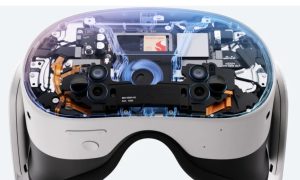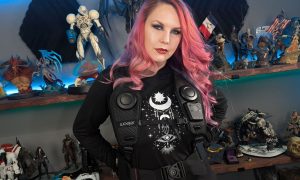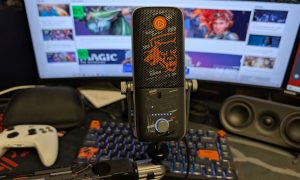
Atlus has been bringing over some of the quirkiest (and best, in many cases) Japanese RPGs to the west for twenty years. One of their hallmark series has been Shin Megami Tensei, which has had two separate series: Devil Sumoner and Persona. In 1999-2000, Atlus released two different games titled Persona 2. The first was Innocent Sin and the second was Eternal Punishment. The games existed as side-stories to each other (with Eternal Punishment being the canonical storyline), however, the west only received Eternal Punishment (due to some very sensitive imagery and a possible homosexual relationship)…until now.
Twelve years after the game’s original release, Atlus has stepped up and brought over the missing chapter in the Persona series: Persona 2: Innocent Sin for the Sony PSP. Featuring updated character graphics, a remixed score and a redesigned user interface (as well as English voice acting), it’s finally time to see what we’ve been missing for all these years. That is, of course, unless you tracked down the very unofficial fan translation of the PS1 title.
The opening to the game features a strong (and psychedelic) opening animation, very similar to what we’ve seen from Persona 3 and 4 previously, which is a nice update from the original opening, which was much more somber and dark in tone. Again, as with many of the Shin Megami Tensei games, there’s not a lot of explanation early on. You’re introduced to the main character, a silent protagonist named Suou Tatsuya (although you can rename him, as well as change his nickname). He seems to be a loner and student at Seven Sisters High School and the game begins with his first task: find the school’s guidance counselor. Of course, this is a Japanese RPG and nothing is ever as easy as it might seem. Wandering around the school gets you through this first task and introduces you to a number of the minor characters as well as the second member of your party (Lisa Silverman, a Caucasian who speaks only Japanese and Cantonese). At this point, you start to get hints of the storyline, with the introduction of the curse that affects the school emblems, supposedly perpetuated by Kasugayama High School (nicknamed ‘Cuss High’).

Upon being told that one of your classmates is being held hostage by a gang leader, you and Lisa take off to confront him. Here you meet ‘Michel’ (real name: Eikichi Mishina), a young man who seems to want to be a visual Kei singer, complete with makeup and dyed-blue hair. It turns out that Michel knows absolutely nothing about this — his gang members were trying to help him create his band and wanted Tetsuya involved. A fight’s a-brewin’, and Michel whips out the reason he’s a gang leader — a Persona. Of course, in an automated combat, it’s revealed that both Lisa and Tatsuya are also Persona users, which brings in Philamon to explain.
At this point the game reveals at least part of the overarching storyline. It seems that it’s popular to play what’s known as the ‘Joker Game’, which involves calling your own phone number on your cell, then expressing your innermost wish to Joker, who will then grant it. Jokingly, Lisa suggests doing this, and she and three of Michel’s band-mates proceed to do so and are very surprised when it actually does summon the being known as Joker. As Lisa stumbles away, surprised, Joker steals the other three’s dreams (as they had no immediate heartfelt desires), turning them into Shadowmen, with little personality and no desire to do anything, doomed to be forgotten by everyone they ever knew. Joker, however, is extremely upset at Lisa, Tatsuya and Michel for something, and is about to kill them all until he realizes that none of them know what he’s talking about. He vows revenge upon the trio, but not until they realize what they’ve done to him….and the game truly begins at that point.
You soon pick up two other characters who are known to players of either Persona or Persona 2: Eternal Punishment in Maya and Yukino early on, and it’s up to the five of you to discover exactly what is going on in a world where rumors can become fact simply by enough people spreading it, demons are everywhere, and people are being all but erased from existence all around you.
The gameplay in Persona 2 takes place in a 3rd-person overhead view, although from a higher perspective than Persona 3 or 4. This normally isn’t a problem, as the graphics are solid and the character portraits are very well-done. The one mild issue I have with the general viewpoint (and honestly, this may be more because of the constraints of a PSP screen than anything) is this: Each character has personal animations to show various emotions, as do the demons. However, on the PSP’s small screen, it’s very hard to tell exactly what’s going on. It was at least three hours into the game before I realized that one of Tatsuya’s animations was of him flicking a lighter open and shut. All of the characters have these little animations, including shrugging their shoulders, laughing, acting upset…and all of them are equally difficult to understand because of this limitation.
 The game does offer an on-screen mini-map in the lower left corner, which shows the path that you’re going as you take it. This is definitely helpful, especially as some of the areas and dungeons can be very maze-like. Having the on-screen map and compass is extremely helpful in these cases. Also, the character pictures and stats are on the lower right side with the name of where you are in the upper left. When you go into combat, the screen goes white and you get a short (usually no more than 3-5 second) loading screen before the battle begins. Again, being an older JRPG, there are a lot of battles. The enemy encounter rate is quite high, but for a good reason: Summoning personas requires many cards.
The game does offer an on-screen mini-map in the lower left corner, which shows the path that you’re going as you take it. This is definitely helpful, especially as some of the areas and dungeons can be very maze-like. Having the on-screen map and compass is extremely helpful in these cases. Also, the character pictures and stats are on the lower right side with the name of where you are in the upper left. When you go into combat, the screen goes white and you get a short (usually no more than 3-5 second) loading screen before the battle begins. Again, being an older JRPG, there are a lot of battles. The enemy encounter rate is quite high, but for a good reason: Summoning personas requires many cards.
Of course, with this being a Shin Megami Tensei game, it revolves around demons. While the Personas are facets of the character’s personalities, they’re also well-represented by the demons that you fight along the way (along with a number of zombies). In fact, your first actual fight brings you into the Contact system, which is the main way you’re going to get the items needed to summon future Personas. When you start a battle, one of your choices is ‘Contact’. You then choose the person (or group of people) to talk to the demon with a variety of prepared responses. Based on who you have talking as well as the demon’s personality type, they’ll either respond with anger, joy, interest or fear. If the demon reaches three levels of any one emotion, the contact will end with varying responses. Joy means that they’ll want to create a pact with you, which can be very useful for an area with a lot of that demon about — talking to a demon with a pact and making them happy again can give you free items, money or information. Maxing out fear will simply make the demon run away, while interest will cause them to give you a number of tarot cards — it’s these cards which allow you to summon more Personas later on, and some of them require nearly 100 cards each. Anger is the worst option, of course, and will cause the demon to immediately attack the party, sometimes bringing along the other enemies for the ride. Worse yet, if it’s a demon you’ve forged a pact with, they can break the pact at that point.

You can always opt to forgo diplomacy and simply fight the demons, especially if it’s a group you do not need cards from. As opposed to other RPGs, you set up the commands for your entire party before each round, deciding who to attack or heal and with normal combat or using various abilities granted by the Personas you wield. The more you use your Persona, the higher in rank (out of eight total) that they raise, and the more abilities they learn. As you unlock abilities, characters can pull off powerful Fusion Attacks, and killing demons this way can cause the Persona to mutate, which brings better stats, new abilities and sometimes greater changes. What’s also nice about the combat is that once you set up a round-based battle plan, you can choose to automate the entire process and even make the game ask before employing any of the Fusion Attacks. When you’re grinding for levels or money, it never hurts to be able to automate the process (unless you’re worried about dying, of course).
Fighting isn’t everything, of course, and you’ll spend plenty of time exploring the city from an overhead map, with markers for the places you can go and people you can talk to. Each district of the city will have a shopping center of some kind, and it’s here that you will visit the various shops including the two most-important places: Rumormongers and the Velvet Room. There are a number of rumormongers in the game, and they’re responsible for giving you the rumors that you can make real (with a cash donation). For example, talking to one person may reveal that a shop sells great quality (if expensive) armor or weaponry, while another may reveal that the same shop sells cheap, low-quality goods. Depending on your goal at the time, you can pay to have one of the rumors spread, then go to the shop to discover that it’s now the truth. Decide you want the more-expensive weapons later? Just pay to change the rumor, and all is well. While these rumors can definitely make the game more interesting or easier, they’re not required. In fact, a number of the rumors are actually difficult to discover and can be fairly easily missed.

The Velvet Room is where all the Persona action takes place, and yes, Igor is here just like he is in the other Persona titles. Bring enough cards of the right aspect and you can make any available Persona, and up to 24 can be stored here (with an additional two slots available in your party plus the five that are currently in-use). Also, once you get a Persona to rank 8, you can release it here, gaining an item or more in the process. Of course, you lose the Persona in question at this point, meaning you’d have to summon another one and rebuild it (if you wanted). You can also find ‘Free’ cards while playing, and these can be used to become any of the other types of cards, which is handy, as a few of the card types can’t be found by contacting demons. Again, however, you don’t have to summon each Persona to beat the game, and it’s fairly easy to miss some of them, giving almost a Pokemon vibe to the entire thing.
Another area in the game is a game-room, which a handy rumor turns into a casino. Not only that, you can choose to make any of the three games (Blackjack with up to five players, video poker or bingo) easier to win. The main reason this is beneficial is because you purchase coins (similar to how a real Pachinko parlor works, which is likely the basis) for cash, and use those coins to play and thus win more coins. These coins are then used to purchase items, and one of them is required to unlock one of the best Persona (at a money to coin value of 1,000,000 yen, no less!).

The music and sound in the game is absolutely amazing. You’ve got the ability to choose the original music or the remixed soundtrack (both composed by Shōji Meguro) and both are very solid, and the sound effects are also very well done, with both music and sound being used to appropriately set mood throughout the game. The voice acting, as well, is very solid across the board. Admittedly, there was a brief period of time when I was ready to lay into Atlus for both the translation and Lisa Silverman’s voice actress. Then, as part of prepping to write this, I happened to pull up a video of the original PSX game with the fan translation and discovered that the nonsense that Lisa seems to talk every sentence is actually Cantonese, and that whether the speaker is a Japanese female or a Chinese-American one (in the case of the PSP release), Cantonese just sounds strange to me.
The end result is that there’s a lot of things to do and find while playing Persona 2, and plenty of things that tie to the other games. With a game length that can easily exceed the 40-60 hour mark and an easily-changeable difficulty switch which can be used on-the-fly (handy if a boss is too difficult), there’s a lot of game here for the forty dollars. The only thing that’s really missing at this point is Eternal Punishment to get a PSP release, and then for Persona 1-4 (all five games) to get a PS3 update. Thank you to Atlus for bringing over one of the missing PSX classics. While it isn’t necessarily aimed at people used to more recent RPGs, Persona 2: Innocent Sin is a prime example of the entire reason many of us have loved Japanese RPGs for years.

I've been a computer gamer since the mid 90s and have been a writer at Gaming Trend since late 2004. My primary interests are RPGs and turn-based strategy, and Japanese imports.

See below for our list of partners and affiliates:
























